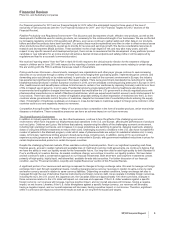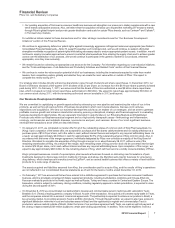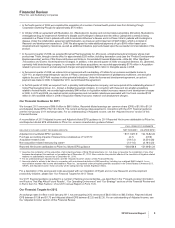Pfizer 2010 Annual Report Download - page 17
Download and view the complete annual report
Please find page 17 of the 2010 Pfizer annual report below. You can navigate through the pages in the report by either clicking on the pages listed below, or by using the keyword search tool below to find specific information within the annual report.
Financial Review
Pfizer Inc. and Subsidiary Companies
Specifically, our 2010 goodwill impairment assessment involved the following:
•To estimate the fair value of our Biopharmaceutical reporting unit, we used a combination of approaches and methods. We used the
income approach and the market approach, which were weighted 75% and 25% respectively, in our analysis. We relied more on the
income approach due to the size of our Biopharmaceutical reporting unit within the pharmaceutical market. For the income approach,
we used the discounted cash flow method and for the market approach, we used the guideline public company method.
•To estimate the fair value of our Consumer Healthcare reporting unit, we used a combination of approaches and methods. We used the
income approach and the market approach, which were weighted equally in our analysis. We weighted them equally as we have equal
confidence in the appropriateness of the approaches for our Consumer Healthcare reporting unit. For the income approach, we used
the discounted cash flow method and for the market approach, we used both the guideline public company method and the guideline
transaction method, which were weighted equally to arrive at our market approach value.
•To estimate the fair value of our Nutrition, Animal Health and Capsugel reporting units, we used the income approach, relying
exclusively on the discounted cash flow method.
•As a test of the reasonableness of our valuation results, we also performed sensitivity analyses and reconciled the aggregate fair value
of our reporting units to an estimate of the market value of our company.
Future Impairment Risks
While all reporting units can confront events and circumstances that can lead to impairment, in general, reporting units that are most
at risk of goodwill impairment are reporting units that are newly acquired, such as our Consumer Healthcare and Nutrition reporting
units, which were acquired as part of our acquisition of Wyeth in 2009. Because we did not have a Consumer Healthcare or Nutrition
reporting unit immediately prior to the acquisition, the assets and liabilities of both reporting units, in their entirety, were recorded at
their fair value as of the acquisition date. As such, immediately after the acquisition date, even small declines in the outlook for these
reporting units can negatively impact our ability to recover the associated goodwill. Also, the asset impairments in these reporting
units were carefully considered during our goodwill impairment review process, as part of understanding the future expectations for
these reporting units. At the end of 2010,
•For our Consumer Healthcare reporting unit, we estimate that it would take a significant negative change in the undiscounted cash
flows, the discount rate and/or the market multiples in the consumer industry for the Consumer Healthcare reporting unit goodwill to be
impaired. Our Consumer Healthcare reporting unit performance and consumer healthcare industry market multiples are highly
correlated with the overall economy and our specific performance is also dependent on our and our competitors’ innovation and
marketing effectiveness, and on regulatory developments affecting claims, formulations and ingredients of our products.
•For our Nutrition reporting unit, we estimate that it would take a significant negative change in the undiscounted cash flows and/or the
discount rate for the Nutrition reporting unit goodwill to be impaired. Our Nutrition reporting unit performance is dependent on our ability
to organically expand our share within a steady growing market.
For all of our reporting units, there are a number of future events and factors that may impact future results and that could potentially
have an impact on the outcome of subsequent goodwill impairment testing. For a list of these factors, see the “Forward-Looking
Information and Factors That May Affect Future Results” section of this Financial Review.
Acquisition of Wyeth
Description of Transaction
On October 15, 2009 (the acquisition date), we acquired all of the outstanding equity of Wyeth in a cash-and-stock transaction,
valued at the acquisition date at approximately $68 billion. In 2009, we recorded provisional amounts for the assets acquired and
liabilities assumed, which were adjusted in the first year after the acquisition date (measurement period adjustments). See Notes to
Consolidated Financial Statements––Note 2. Acquisition of Wyeth.
Wyeth’s core business was the discovery, development, manufacture and sale of prescription pharmaceutical products, including
vaccines, for humans. Other operations of Wyeth included the discovery, development, manufacture and sale of consumer
healthcare products (over-the-counter products), nutritionals and animal health products. Our acquisition of Wyeth has made us a
more diversified healthcare company, with product offerings in human, animal, and consumer health, including vaccines, biologics,
small molecules and nutrition across developed and emerging markets. The acquisition of Wyeth also added to our pipeline of
biopharmaceutical development projects endeavoring to develop medicines to help patients in critical areas, including oncology,
pain, inflammation, Alzheimer’s disease, psychoses and diabetes.
Recording of Assets Acquired and Liabilities Assumed
The transaction has been accounted for using the acquisition method of accounting which requires, among other things, that most
assets acquired and liabilities assumed be recognized at their fair values as of the acquisition date and that the fair value of acquired
IPR&D be recorded on the balance sheet.
While most assets and liabilities were measured at fair value, a single estimate of fair value results from a complex series of
judgments about future events and uncertainties and relies heavily on estimates and assumptions. Our judgments used to determine
the estimated fair value assigned to each class of assets acquired and liabilities assumed, as well as asset lives, can materially
impact our results of operations.
2010 Financial Report 15
























